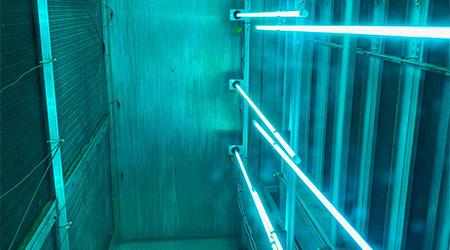As hospitalization rates from the COVID-19 pandemic continued to rise, facility managers at Chicago’s Loyola University Medical Center sought to add another infection mitigation layer to their already stringent protocols.
Campus facilities engineers identified germicidal UV-C as an ideal airstream disinfection complement to existing infection controls, based on the technology’s decades of proven efficacy and thousands of successful “real-world” applications. Both the U.S. Centers for Disease Control and Prevention (CDC) and ASHRAE include UV-C as a recommended mitigation step to slow the spread of the SARS-CoV-2 virus.
Moreover, infectious disease experts believe that, when aerosolized, the COVID-19 virus is likely to be more susceptible to UV-C damage than other coronaviruses such as SARS-CoV-1 or MERS-CoV.
Beyond reducing the spread of the SARS-CoV-2 virus, facility engineers saw the antimicrobial technology as an additional means to reduce healthcare-associated infections (HAIs). Early research shows a nationwide rise in HAIs during the pandemic, according to a commentary published in the American Journal of Infection Control. Researchers note that suppressed immune systems among COVID-19 patients place them at higher risk for HAIs.
Prior to the pandemic, healthcare researchers recognized “UV disinfection holds promise for reducing the level of contamination in operating rooms and thereby lowering the risk of infection for patients,” as stated in the article Ultraviolet Disinfection in the Prevention of Surgical Site Infections.
With this background in mind, facilities staff at Loyola University Medical Center decided to add UV-C airstream disinfection to the HVAC system that serves the operating room suites at the University’s Hospital Expansion Tower. In October 2019, the project team reached out to Richard Pasquesi, a sales engineer with HVAC Equipment Representative Thermosystems LLC.
Pasquesi recommended the high-output RLM Xtreme fixtureless UV-C lamp system from UV Resources. Designed for high-volume HVAC environments, the versatile RLM Xtreme can be installed in almost any position to generate 360-degree high output UV-C irradiation to inactivate bacteria, viruses, molds, and other pathogens– including antibiotic-resistant superbugs.
“We identified three areas within the 30,000 cfm rooftop air handler where we could disinfect airstreams and cooling coils that serve six of the hospital’s surgical suites,” says Pasquesi. “We installed one bank of UV-C fixtures upstream of the precooling coil to disinfect airstreams, while two additional banks were placed downstream of the precooling coil and the subcooling coil to keep the coils, drain pan and plenum free of infection-causing and efficiency-robbing microorganisms.”
According to Pasquesi, this second installation position was of particular interest to the surgical pavilion’sfacility staff, who saw the value in both improving indoor air quality and reducing required maintenance on the cooling coils. The moist and dark environment inside an air handler serves as an ideal breeding ground for bacteria and biofilm.
“Although COVID-19 was top-of-mind for project managers, this technology also allowed the team to protect patients and staff from influenza, Tuberculosis and other airborne pathogens that contribute to healthcare-associated infections,” says Pasquesi.
After seeing the potential benefits of the newly installed germicidal disinfection system, facilities staff agrees that this technology has become an important component of the ever-increasing infection mitigation controls throughout the 61-acre medical center campus, which includes a trauma center, burn center and children's hospital.

 How Efficiency Checklists Help Hospitals Save Energy, Water and Money
How Efficiency Checklists Help Hospitals Save Energy, Water and Money Designing with Heart: Seen Health Center Blends Cultural Warmth and Clinical Care
Designing with Heart: Seen Health Center Blends Cultural Warmth and Clinical Care Rutgers Health and University Hospital Breaks Ground on Campus Expansion
Rutgers Health and University Hospital Breaks Ground on Campus Expansion What to Consider When Modernizing Healthcare Facilities
What to Consider When Modernizing Healthcare Facilities Corewell Health Beaumont Troy Hospital to Build New Tower
Corewell Health Beaumont Troy Hospital to Build New Tower